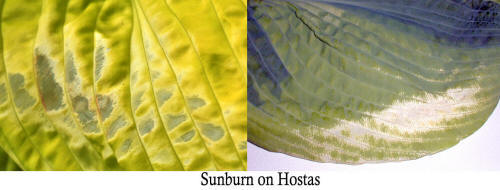You always hear the
phrase that hostas are "shade-loving" plants. Of course,
this is an incorrect statement since all plants require
light at some level for
photosynthesis. More correctly, hostas are "shade-tolerant' plants that can survive at
lower light intensities.
Sunlight is also
important for plants because it heats the leaf surface
as causes evaporation (transpiration in plants) which
helps pull water up from the roots. Plants that are
adapted to the shade have vascular systems that are also
adapted to a lower level of transpiration since they
normally are not exposed to high intensity sunlight.

So, when you put hostas
out in the sunlight, they may be asked to replace the
water that evaporates off their leaves at a rate faster
than their "pipe system" will allow. When this happens,
the cells in the tissue furthest from the roots tends to
die first. That is why this damage usually is most
pronounced at the edges of leaves or in the variegation.
Many people rate hostas
by leaf color in terms of the amount of sunlight they
can manage. Yellow (H. 'Sun Power') or light green
(H. 'Sum and Substance') will thrive in high light
situations AS LONG AS THEY ARE GIVEN ADEQUATE WATER.
This means preparing the soil with plenty of compost or
other organic matter and regular irrigation during the
hottest parts of the summer.
Next in line would be the
green (H.
Royal
Standard') or blue (H.
Blue
Umbrellas') which can also thrive in high light levels
with adequate water. We tend to put the blue hostas in
more shade not because they will grow better but because
they will stay blue longer into the season. Remember
that the blue is due to a waxy coating on the leaf and
this will wear off sooner in the bright sun.
Variegated hostas are
often a case by case judgment. Certainly ones with wide
areas of white variegation should be in the heavier
shade or they will probably "melt
out".
So, how do you manage
sunburn? First and foremost, make sure your soil has
plenty of organic matter in it. Second, avoid putting
highly variegated hostas in areas that receive intensive
sunlight especially in the later afternoon.



